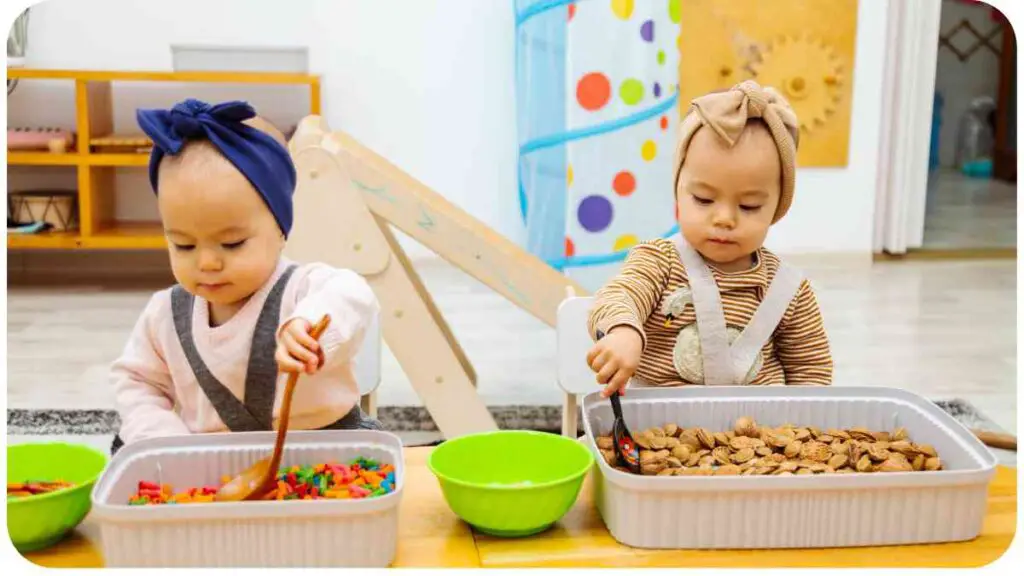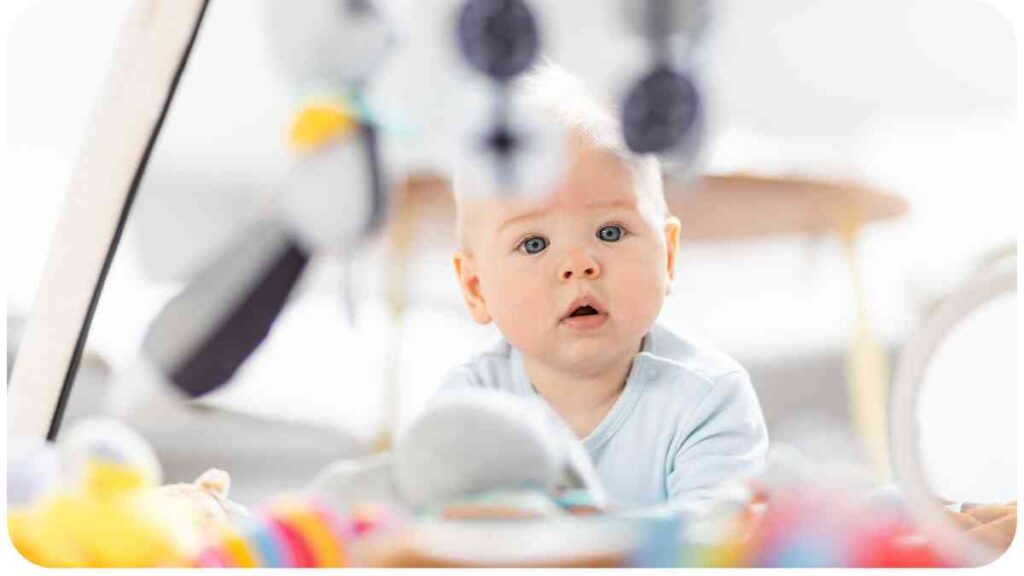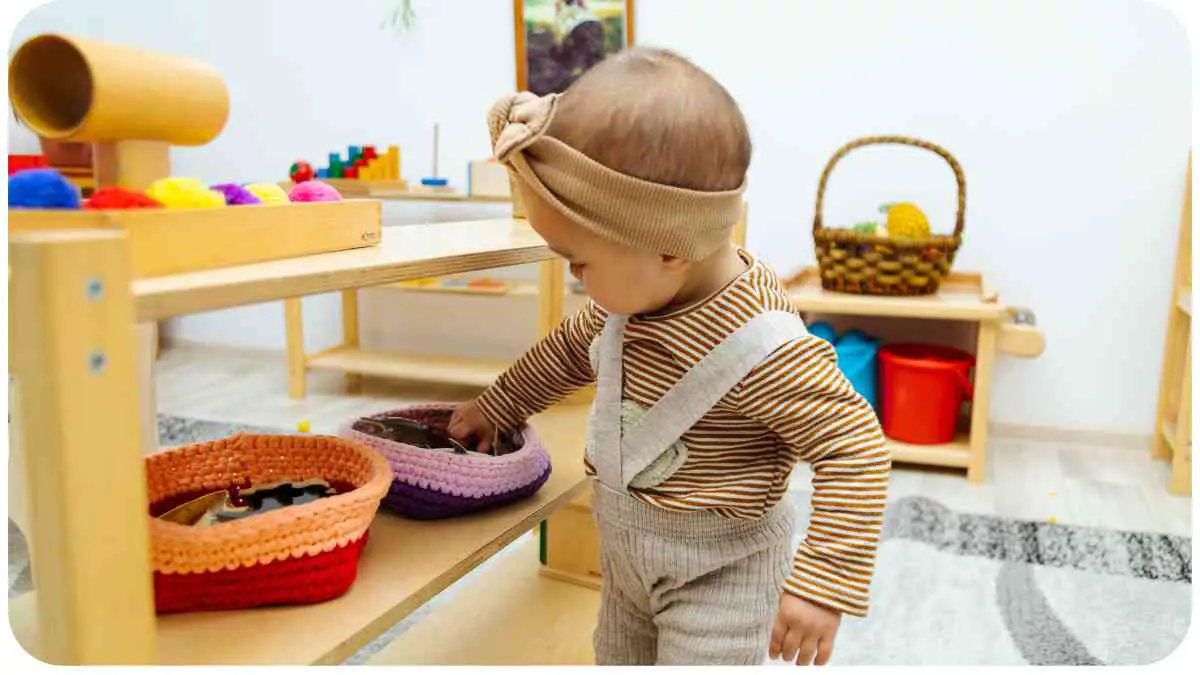Sensory toys are designed to stimulate and engage a child’s senses, supporting their sensory development. These toys are carefully crafted with various textures, colors, sounds, and scents to offer a multi-sensory experience for toddlers.
| Takeaways |
|---|
| Choose sensory toys based on your child’s age and developmental stage. |
| Consider safety factors such as choking hazards and non-toxic materials when selecting sensory toys. |
| Sensory play supports cognitive, motor, language, emotional, and social development in toddlers. |
| DIY sensory toys can be a budget-friendly option and allow for customization based on your child’s preferences. |
| Follow your child’s lead during sensory play and encourage exploration and experimentation. |
| Sensory toys can be beneficial for children with autism or sensory processing disorders. |
| Create a sensory-friendly environment for optimal engagement in sensory play sessions. |
Importance of sensory play for toddlers
Sensory play is crucial for the overall development of toddlers as it helps them explore and make sense of the world around them. Engaging with sensory toys fosters cognitive, social, emotional, and physical growth, facilitating learning and creativity.
Understanding the significance of sensory play is crucial for a toddler’s development. Explore this guide to ensure your child benefits from the right sensory toys from the start.
2. Understanding Sensory Development in Toddlers
The five senses and their role in development
Toddlers rely on their five senses – sight, hearing, touch, smell, and taste – to explore and understand their surroundings. Each sense plays a vital role in their cognitive development, helping them gather information and make connections with their environment.
Benefits of sensory play for toddlers

Sensory play offers a range of benefits for toddlers. It promotes:
- Cognitive development: Engaging with different sensory experiences helps improve problem-solving, decision-making, and memory skills.
- Fine and gross motor skills: Manipulating sensory toys allows toddlers to develop their hand-eye coordination, dexterity, and overall physical skills.
- Language development: Sensory play encourages vocabulary expansion as toddlers learn to associate words with different sensory experiences.
- Emotional regulation: Sensory activities provide a calming effect, helping toddlers manage their emotions and reduce stress or anxiety.
- Social skills: Sensory play can be enjoyed with others, promoting social interaction, cooperation, and turn-taking.
Curate your toddler’s playtime with the 15 essential sensory toys. Discover these must-haves that contribute to their holistic growth and provide endless hours of engaging and educational fun.
3. Factors to Consider when Choosing Sensory Toys
Age appropriateness
When selecting sensory toys, it’s important to consider the age of the toddler. Different age groups have unique developmental needs and abilities, and toys should be chosen accordingly to ensure safety and engagement.
Safety considerations
Ensure that the sensory toys you choose are safe for your child. Avoid toys with small parts that could pose a choking hazard. Additionally, check for non-toxic materials and ensure the toys meet safety standards.
Material quality
Opt for sensory toys made from high-quality materials that are durable and easy to clean. Consider the texture, safety of any attached components, and the overall construction of the toy to ensure it withstands rigorous play.
4. Types of Sensory Toys and Their Benefits

Visual toys
Visual toys focus on stimulating a toddler’s sense of sight. These toys may include brightly colored objects, contrasting patterns, and toys with lights or moving parts. Visual toys contribute to visual perception development and color recognition skills.
Choosing the right sensory toys is key for your toddler’s development. Learn expert tips on selecting toys that cater to your child’s unique needs, ensuring a well-rounded and enriching play experience.
Auditory toys
Auditory toys engage a toddler’s sense of hearing. They may feature musical instruments, sound-producing toys, or toys that mimic animal sounds. These toys promote sound discrimination, listening skills, and rhythm appreciation.
Tactile toys
Tactile toys provide tactile stimulation, targeting a toddler’s sense of touch. They can range from soft plush toys and textured balls to squishy toys and objects with varying tactile surfaces. Tactile toys enhance sensory exploration, fine motor skills, and tactile discrimination.
Olfactory toys
Olfactory toys stimulate a toddler’s sense of smell. These toys often incorporate scented materials, such as scratch-and-sniff books, scented playdough, or scented markers. Olfactory toys aid in scent recognition and sensory awareness.
Gustatory toys Gustatory toys are designed to engage a toddler’s sense of taste. These toys can include teething toys, flavored edible playdough, or textured toys that promote oral exploration. Gustatory toys facilitate taste exploration and promote the development of oral skills.
5. Recommended Sensory Toys for Different Stages of Development
Newborn to 6 months
- Soft cloth books with colorful pictures and different textures.
- High-contrast mobiles or toys with black and white patterns.
- Rattles or toys that make gentle sounds.
6 to 12 months
- Sensory balls in various sizes, textures, and colors.
- Stackable toys or shape sorters to encourage fine motor skills.
- Musical toys that respond to touch or movement.
Enhance your toddler’s physical development with sensory toys designed to build stronger muscles. Explore the options that make playtime not only enjoyable but also beneficial for fostering gross motor skills and physical strength
12 to 18 months
- Pop-up toys or toys with buttons that trigger surprises.
- Nesting cups or blocks for stacking and spatial awareness.
- Musical instruments like tambourines or xylophones.
18 to 24 months
- Puzzles with chunky pieces for problem-solving and motor skills.
- Water or sand play toys with scoops and sieves.
- Role-playing toys like kitchen sets or doctor kits.
2 to 3 years
- Building blocks for creative construction and imagination.
- Art supplies like crayons, finger paints, or modeling clay.
- Pretend playsets such as dollhouses or tool sets.
6. DIY Sensory Toys for Budget-Friendly Options
Sensory bottles
Create sensory bottles by filling empty plastic bottles with a variety of materials such as glitter, colored water, or small objects. Secure the lid tightly to prevent leakage or choking hazards.
Sensory bags
Fill ziplock bags with different textured materials like rice, beans, or sensory gel. Seal the bag tightly and offer it to your toddler for exploring the textures through touch.
Sensory bins
Use a large container or plastic tub and fill it with items like colored pasta, kinetic sand, or water beads. Add scoops, cups, and small toys for a multi-sensory experience.
Take sensory play beyond indoor spaces with creative outdoor activities. Discover exciting ideas that stimulate your toddler’s senses while enjoying the benefits of fresh air and nature, promoting holistic growth and development.
7. Tips for Engaging and Interactive Sensory Play Session
Create a sensory-friendly environment
Designate a specific area for sensory play where your toddler can freely explore without distractions. Use soft lighting and calming music to create a soothing atmosphere.
Follow your toddler’s lead
Observe your child’s interests and allow them to choose the sensory toys they want to engage with. Follow their lead and provide support, but also encourage independent exploration.
Encourage exploration and experimentation
Ask open-ended questions like, “What does it feel like?” or “How does it sound?” to encourage your toddler’s curiosity and critical thinking. Allow them to experiment with different ways of interacting with the toys.
8. Sensory Play for Children with Special Needs
Toys for children with autism
Consider toys that promote sensory integration, such as tactile discs, weighted blankets, or sensory swings. Visual stimulation toys like bubble tubes or projector lamps can also be beneficial.
Toys for children with sensory processing disorders
Choose toys that provide deep pressure, like weighted toys or compression vests. Sensory fidget toys that offer both tactile and auditory stimulation can also be helpful for regulation.
9. Conclusion
In conclusion, choosing the right sensory toys for toddlers is a crucial aspect of their development. By understanding the role of sensory play and considering factors such as age appropriateness, safety, and material quality, parents can provide their children with engaging and enriching experiences.
The recommended sensory toys, along with the DIY options, offer a wide range of options to cater to different stages of development. Sensory play promotes cognitive, motor, and social skills while providing a fun and stimulating environment for toddlers. By incorporating creativity, personal experiences, and professional expertise, parents can make informed choices and create an engaging sensory playtime for their toddlers.
Further Reading
Here are some additional resources to further explore the topic of sensory toys and their benefits:
- Your Kid’s Table: Choosing the Right Sensory Toy: This article provides comprehensive guidance on selecting the right sensory toys for your child, including factors to consider and specific recommendations for different age groups.
- Description: Your Kid’s Table offers valuable insights into choosing sensory toys that are suitable for your child’s developmental needs. This resource provides practical advice and helpful recommendations to ensure you make informed choices.
- Parents: An Age-by-Age Guide to Sensory Toys: Parents.com offers an age-specific guide to sensory toys, helping parents understand which toys are most suitable for their child’s stage of development.
- Description: Parents.com provides a comprehensive guide on sensory toys, categorizing them according to different age groups. This resource assists parents in selecting toys that align with their child’s developmental milestones.
- Tulikids: Sensory Toys 101 – A Comprehensive Guide: Tulikids offers a detailed guide to sensory toys, outlining their benefits and providing recommendations for the best picks for young children.
- Description: Tulikids presents a thorough overview of sensory toys, covering their benefits and suggesting top choices for children. This resource offers valuable insights to help parents make informed decisions when selecting sensory toys.
FAQs
Here are some frequently asked questions about choosing sensory toys for toddlers:
What age range are sensory toys suitable for?
Sensory toys are available for a wide range of ages, from newborns to older children. It is important to choose toys that are age-appropriate and align with your child’s developmental stage.
How do sensory toys benefit toddlers?
Sensory toys promote sensory exploration and development, aiding in cognitive, motor, and social skills. They provide opportunities for enhanced learning, creativity, and emotional regulation.
Are there safety considerations when selecting sensory toys?
Yes, safety is paramount when choosing sensory toys. Ensure the toys are free from small parts that could pose a choking hazard, and opt for toys made from non-toxic materials. Always follow age recommendations and consider any specific safety precautions.
Can I make my own sensory toys at home?
Absolutely! DIY sensory toys can be a great option, both for budget-friendly alternatives and for customizing the sensory experience to your child’s preferences. There are many online resources and creative ideas available to guide you in making your own sensory toys.
How do I know if a sensory toy is suitable for my child’s specific needs?
Every child is unique, and what works well for one child may not be as effective for another. It’s important to observe your child’s preferences and developmental progress, considering their specific needs and abilities when selecting sensory toys.

Meet Hellen James, the multi-talented writer and nurturing mother who takes young readers on a thrilling journey through her sensory-infused blog. Drawing inspiration from her own experiences as a parent.

